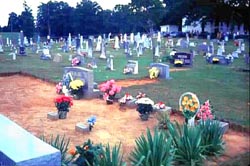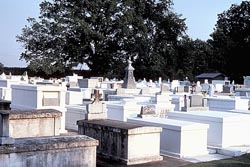Cemetery Preservation Guide
By Sheila Richmond

Visiting a historic cemetery is a wonderful way for students to learn about their community. Cemeteries provide information about history, burial customs, and local traditions. Students can research gravestone materials, symbols, art, epitaphs, weathering, sizes, shapes, immigrants, natural disasters, epidemics, plants and shrubs, trees, mapping, memorials, songs, genealogy, and many other topics.
With so much information to be derived from and so many ways to use a cemetery, one of the primary concerns should be to implement the best preservation and conservation practices to ensure that the cemetery can continue to serve as such a vital source of our collective heritage. The following tips should aid in this endeavor.
Do a pre-Field trip Safety Check!
Safety is always a primary concern when planning a field trip. Teachers should visit a cemetery before bringing students to identify safety concerns.
- Check for uneven terrain, sunken areas, and holes
- Look for broken gravesites, protruding tree roots, broken fence posts, and other sharp objects.
- Identify hazardous grave markers and be aware that markers that appear stable may be hazardous.
- Avoid poison ivy or poison oak.
- Watch for snakes, ants, mosquitoes, spiders, bees, wasps, and other harmful pests.
- Mark boundaries so your students know which areas to avoid.
- Consider the need for sun screen, bug spray, or rain gear.
- Bring lots of water.
NEVER do a gravestone rubbing!
The practice of rubbing a gravestone to gather information is extremely harmful to these storehouses of history. When one considers that it is usually the oldest, most delicate ones that are popular, the concerns are compounded:
- Many gravestones look sturdy, but in reality are not. Often the slightest nudge will not only shift a stone on its base, but may just as easily topple the whole structure. The pressure of pushing onto a gravestone to do a rubbing can cause significant structural damage.
- When attempting a rubbing, often people not only push against upright gravestones, but they also sit on the grave itself to do a rubbing. Don't assume that because the material looks sturdy that it is. Sitting on the stone can cause sections to break off.
- Because gravestones are made of natural materials and are exposed to all types of weather -- especially freezing and thawing -- cracks begin to develop. The pressure of rubbing can not only increase unnoticeable cracks on a gravestone, but it can also create cracks that lead to deterioration.
- The materials used to do the rubbings can be extremely harmful. Glue from the tape, acid from the paper, and minute particles of the chalk, pencil, pen, or crayon will remain on the gravestone. These traces can cause a chemical reaction that will weaken the stone, will sometimes stain the stone, or will serve as incubation area for bio growth such as lichen and algae which also lead to the destruction of gravestones.
When trying to gather information from a gravestone, consider proven alternatives! A picture can provide great documentation; even better is the technology of a digital image. These electronic images can be manipulated with computer software to highlight areas and help make the inscription readable. If you think that you may have trouble reading an inscription on a gravestone or gathering other information, consider the following tips:
- Time your visit so that the sun provides optimum light.
- If the gravestone never gets great light, take a mirror to reflect sunlight. A piece of cardboard wrapped with foil can also be used.
- Use a spray bottle to lightly spray water across the inscription.
- Do a drawing of the gravestone.
Careful Maintenance is the Key!
People who are interested in cemeteries want to make sure that these sites not only look good, but provide easy access to information on the gravestones. Too often this interest in beautification results in inappropriate cleaning and maintenance.
- Carefully consider what to plant and where and bear in mind what the plant will look like in the future. You have seen evidence of flora destruction -- trees growing over or through gravestones, shrubs covering the gravestone, roots toppling fences, branches scrapping gravestones, and others.
- While you do want to trim branches that are rubbing against or otherwise harming gravestones, keep in mind that in certain traditions, the plant is an integral part of the memorial and removing it would be desecrating a grave.
- Cutting grass and trimming weeds are necessary to maintain a cemetery so that the grave sites are accessible to visitors. Extreme care should be taken, however, to ensure that the machinery does not cause harm. Lawn mowers and weed-eaters can scrape, scratch, and chip the gravestone. Any grass next to gravestone should be hand-trimmed.
- Never use a weed killer next to a gravestone as it is absorbed by the stone and causes chemical damage.
- The safest method of cleaning a gravestone is plain water with a soft brush. Never use bleach, harsh detergents, chemicals, pressure washers, hard-bristle brushes, or scrapers. Often the material on the stone is lichen or algae, not dirt. Consult with a professional about cleaning if plain water doesn't do the job.
- Never remove pieces of a gravestone; professionals have successfully repaired gravestones that were jumbles of pieces that had to be fitted together like a jigsaw puzzle.
- Carefully consider local burial customs and traditions before removing items from a grave site. Mementos such as toys, pictures, cigarettes, stones and even soft drink cans or beer bottles can be signs of respect left by friends and family.



